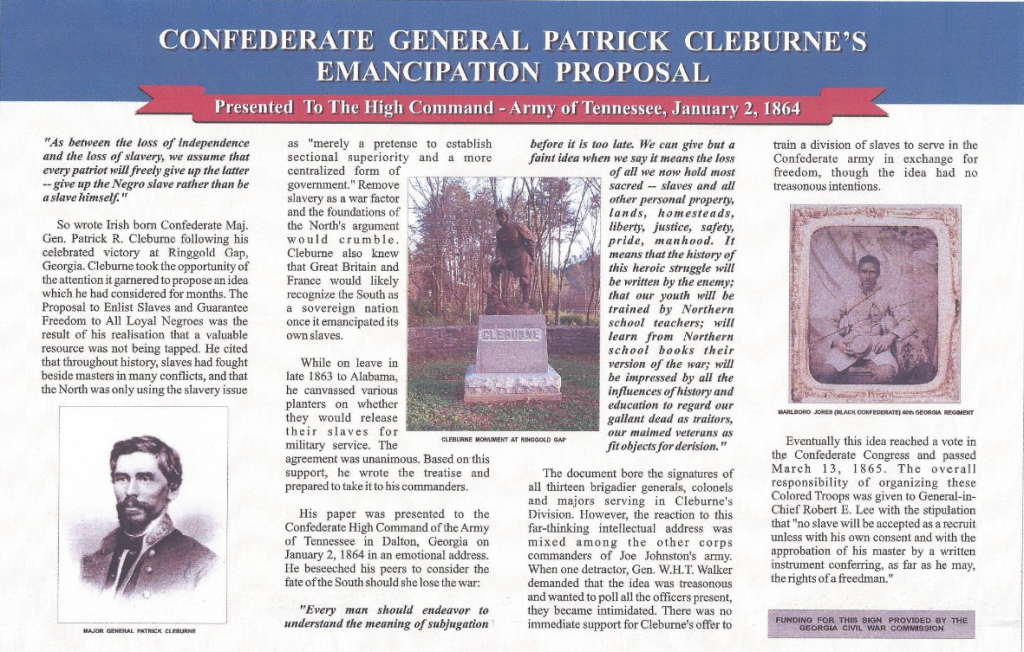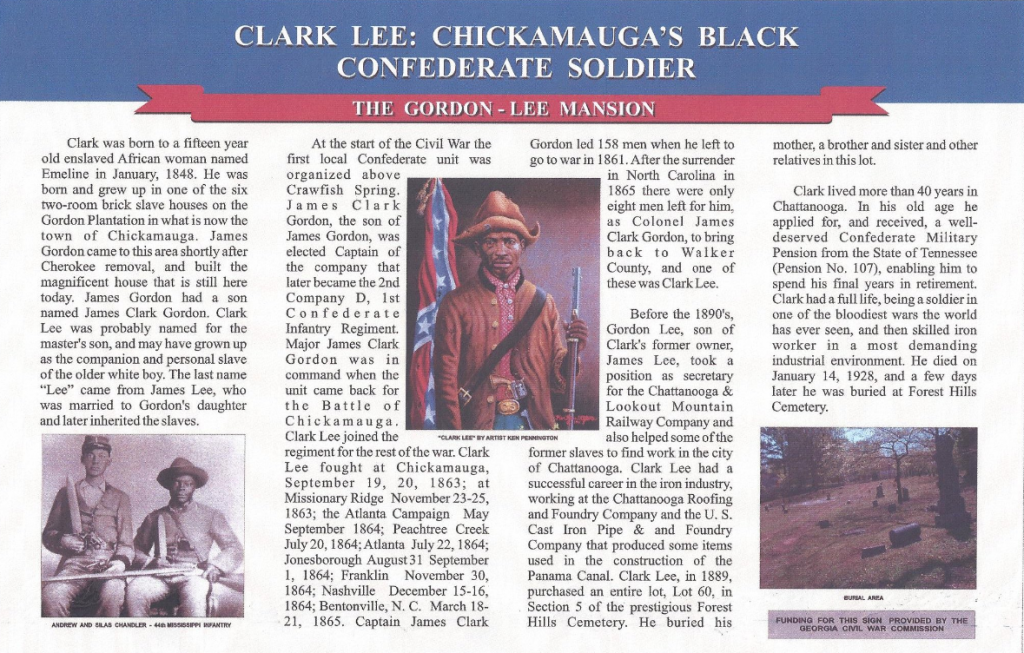Update: Once again, thanks to Andy Hall for doing the leg work of looking into the documentation behind the claim that Clark Lee was a Confederate soldier. No surprise by what he did not find to support such a claim nor that what is available points to a very different picture of Lee’s presence in the the army.
I have no doubt that the Georgia Civil War Commission has done some excellent work in the area of battlefield preservation, but this is the kind of website that troubles me as both a historian and especially as a teacher. Check out the following two panels that the commission has unveiled in recent years. The list of members does not include anyone prominent in the field of Civil War history and given what I have to share with you I am not surprised one bit to find Charles Kelley Barrow’s name on this list. Barrow is a member of the Sons of Confederate Veterans and has been a vocal advocate of the black Confederate narrative over the years.
The first panel tells the story of Confederate General Patrick Cleburne’s plan to enlist slaves into the army.

It is clear that not much thought went into this text. No mention is made that not only was Cleburne’s plan immediately rejected by President Davis and others, he was ordered not to discuss it further. Also conveniently left out is any sense of just how controversial this plan was throughout the Confederacy as it was debated in the army, on the home front and in Richmond at the very end of the war as a means to stave off defeat.
Next is a profile of what is suppose to be a real black Confederate soldier. Let’s see.

Again, we have another poorly written panel that leaves more questions than answers. First, it is clear from the text that Clark Lee was not a soldier. He was born a slave. There is no evidence here that he was ever freed and if I had to guess he became attached to his master’s son once the war came to Chickamauga. The pension that he received was not a “Confederate Military Pension” but one designated to former slaves who served their masters during the war. It looks like the illustrator used the Chandler image as a guide for his depiction of Clark Lee. The photograph is incorrectly identified since it suggests that both Andrew and Silas were soldiers. We know that is not true. To think that these two panels are being read by the general public is truly horrifying.
The larger problem is one that I’ve harped on for some time now. Here is an organization and a website that is sanctioned by the state of Georgia. Anyone doing a search on these subjects will likely not question the information presented here and/or on the plaques themselves. It goes without saying that the Georgia Civil War Commission should not be confused with the Georgia Historical Society’s historical marker program, which is a legitimate public history project.
Thanks to Lee White for bringing this to my attention.
Hello Mr. Hall,
I am a little late to this conversation. However, I found this post (and excellent blog I must say!) as a result of googling the Georgia Civil War Commission. A little background. I just recently finished my Master’s in history at the University of Alabama and had the privilege to study under Dr. George Rable, among others. I have taken some time off to discern what my next step is, either a PhD or law school with a focus on urban planning/historic preservation. Thus, I have recently move back to Atlanta, Georgia and was dismayed by this “Georgia Civil War Commission.” I began following them on facebook and had to unsubscribe shortly thereafter for the very questionable posts and the behavior of certain posters. When searching the commission, I came across your blog and I thank you for your post on this issue. Please trust that not all of us Georgians endorse such revisionist history. Thank you for your time and I look forward to more of your blog posts.
Best,
Ian Michael W. Rogers
Hi Ian,
Thanks for the comment and welcome to the blog. Congrats on finishing your M.A. at Alabama. Working with Rable must have been a great experience.
I want to add another proposal to enlist slaves; William C. Oates of the 15th Alabama (the one that charged Chamberlain at Little Round Top). In his biography of Oates, Gettysburg Requiem, G.W.LaFantasie discusses Oates proposal in Richmond, 1863. Then Captain, Oates proposed offering enlisted slaves freedom and land after term of service. His congressman, (former law partner and friend) James L. Pugh is quoted as saying: ” if we free the negroes to make soldiers of them, that is simply throwing aside the bone of contention and we had as well stop the war at once.”
By the way, thank you Mr. Hall for your hard work.
It would seem to me that if they wanted to honor “Chickamauga’s Black Soldier,” they’d start with the 44th USCT – which was raised in the Chickamauga/Chattanooga area. Given that there were 1,300 men in this unit, I don’t think it’s all that odd that there would be black soldiers from the town. Of course, these aren’t the black soldiers they’re looking for.
Their Facebook page–today sporting a new “black Confederate” cover image as Brooks Simpson notes–shows zero interest in Georgians black or white who supported the Union. If Facebook had existed in the 1960s, it is what all of the southern commission pages would have looked like. No wonder the governor slashed their annual budget from $10,000 to nothing.
Looks like they deleted the link to this post. No surprise.
I suggest that you may learn much if you look at the composition of the commission.
http://cwcrossroads.wordpress.com/2013/06/13/the-georgia-civil-war-commission-stumbles/
You can thank me later.
Thanks Brooks. I pointed out Kelley Barrow’s connection to the SCV, but thanks for following up on the rest of these characters.
Oh and the one about the Roswell mill is a real treat. Of course, there is no mention that the mill was operating under a French flag, which was total ruse. So if anybody should be blamed for what was going on there, it should be Confederate authorities who put Southern civilians to work in a mill and tried to be clever by flying the flag of another country and thus claiming some sort of neutrality. What a bunch of hogwash.
Oh, look — Bill Yopp.
Kevin, I just e-mailed you an image of a marker noting Cleburne’s slavery proposal erected by the Georgia Historical Society.
Ok, you got me there.
Quite interesting how the marker text is verbatim to what is on Find-a-Grave. As for his being a “soldier,” well, I think we have all been down this road quite a few times. Aside from the fact that he has no service record, and blacks were not allowed to serve in the ranks until the closing weeks of the war, I am pretty certain he wasn’t fighting at Franklin (or anywhere else), any more than Uncle Wiley Howard was, who was a slave owned by Brig. Gen. States Rights Gist. I find the painting amusing and patronizing. He really is decked out with his fancy slouch hat, pistol, rifle, and CS buckle. Anyone not pushing an agenda would know that such imagery is just imaginary.
Anyone not pushing an agenda would know that such imagery is just imaginary.
I wish I could be as optimistic.
Have to agree. The ACW, like the rest of our history, is lost on most people. David McCullough’s complaint about history not being a required undergraduate subject hits home. Most people will happily accept imaginary imagery without question.
Good catch on the Find-a-Grave text. Same with the elements of the painting. I’d only add that the man in the painting doesn’t look to me like a fifteen-year-old, which would have been Lee’s age at Chickamauga.
Another form of copy and paste that is so common on these websites.
The Clark Lee panel seems to be based on a 2011 book by E. Raymond Evans, The Life and Times of Clark Lee: Chickamauga’s Black Confederate Soldier. Evans gives local talks on the subject and sells his book, but I can’t find it with the major online sellers.
It’s not available with any major sellers. I came across it on sale on one site, but it’s note even a book. More like a binder of information.
I’ve met Mr. Evans. He lives around the Chattanooga area. He also wrote the book titled Cleburne’s Defense of Ringgold Gap which I looked at a few years ago. A dry narrative history at best. His books are published by Mountain Press (http://www.mountainpress.com/), which is a local publishing company outside of Chattanooga that handles mostly genealogy works.
I cannot really speak about Mr. Evans because I only met him once, and it was a brief encounter at that. But he was sitting under an SCV tent at a re-enactment in North Georgia. They knew him pretty well, and knew about his work. They pointed him out when a friend of mine mentioned a paper I did on the Battle of Ringgold Gap.
As far as his books, you can check them out at libraries in and around Chattanooga. That is the only place that I came across book on Cleburne. I never found a website where I could buy the book.
He is said to be something of a local anthropologist.
http://www.catoosanews.com/view/full_story/18263151/article-Raymond-Evans-uncovers-area%E2%80%99s-treasured-past?instance=lead_story_bullets_left_column
In this case, though, Google Books lists the publisher as “J. Culpepper.” Is it reasonable to surmise that that’s John Culpepper, chairman of the commission and city manager of Chickmauga, Georgia?
That would also explain why the town sells the work — for $30 — in their gift shop.
Could be. Next time I am in Chickamauga I’ll have to take a look. I’ll be up there this weekend.
All historical inaccuracies aside (which are many and profound), this is just plain BAD exhibit/panel/interpretive text. It’s so damn long. Talk about book on a wall.
Ouch.
Overall a poorly executed panel.
Kevin, this is a semi-related question–Have you or anyone else explored the notion that the reason black Confederates have gained traction is the novelty of the concept? When I hear the concept from non-academics, they usually ask me with wide-eyed excitement, “Did you know blacks fought in the Confederate army?” Or something along those lines. It is the same excitement I see in people who bring up Churchill attacking the French Fleet in 1940 or the last Japanese surrender occurring the 1950s. People love that novelty factor.
No doubt. You definitely get the sense from some people that they have discovered something that has fallen through the cracks. Closely related is the claim that there is a conspiracy to keep this story under wraps. You can find on a number of sites a claim attributed to Ed Bearrs and others that the subject has been intentionally ignored.
That pension money for former slaves was the BEST money the Lost Cause even spent!!
Classic Barbara comment. I love it. 🙂
Nicely played, ma’am. Nicely played.
It is truly hard to stop ignorance once it gets rolling. I’ve found this to be true as a teacher and as a human being. The best we can do is to point out the errors. And for that, we have Kevin, and probably others, who “keep on keeping on” as we said in the 60’s.